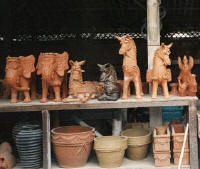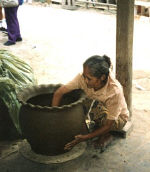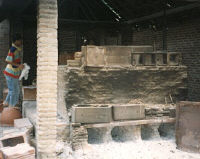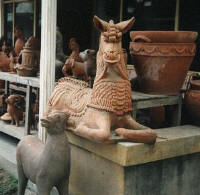Kasongan, a Quaint Pottery Village
Central Java, Indonesia


What I intended to see was the grassroots of pottery in Central Java – a small village outside the town of Bantul called Kasongan. At one time, the village was a mere ‘suburb’ of Bantul. However, everything changed after Independence was declared in Indonesia on the 17th August, 1945. Kasongan became a village in its own right. It had for centuries, been infamous as the centre for ‘erotic’ pottery. Many pieces can still be found in museums within Indonesia, but to find them in Kasongan nowadays was like, as they say, looking for a needle in a haystack.
The morning had already become hot, the sun fierce and unrelenting, when we set off for Kasongan. From the city of Magelang in Central Java, the trip should have taken ninety minutes at the most. A flat tire, a boiling radiator, and some ‘pit-stops’ for yummies and drinks, made it more like a day trip. Romadi, my old friend in Magelang, who ran a craft shop, and I were extremely happy to see the flat open plains after the drive down from the mountains which are the backbone of Java. This was the fertile area. Like a multi-green coloured patchwork quilt, the paddy fields stretched seemingly to the horizon, the farmers tending the rice crop, the women planting the seedlings – a backbreaking job I would never desire to do. The long straight road seemed to fall off the horizon together with the paddy fields, and as I became impatient, Romadi assured me it was not much further. He had said the same thing fifty miles back. As the road became narrower, started dipping and rising across small creeks, my impatience soon dissipated.
Entering the village was just like entering any other village in Indonesia. Two tall stone pillars, one either side of the road, displayed the name of the village. I was disappointed to see graffiti haphazardly scrawled over the pillars. When I mentioned my disapproval of such actions to Romadi, he only replied, “Your Western influence.” Naturally, I didn’t take that personally! The narrow, pot-holed dirt road was more like a rough bush track. Romadi and I seemed to concur that walking would be far more beneficial. Besides, when you drive through anywhere, you never ‘see’ the place, or even get a feeling of its cultural value.
On either side of the road leading down the hill were pottery shops. Each displayed their wares, proudly placed on wooden planks supported by a pile of concrete bricks. I was eager to see how the pottery was made and why it was so popular – more so now since Kasongan has become a part of the ‘tourist track’. Finding a warung (a cheap, often mobile place to eat) was not hard. They were scattered up and down the road. My hopeful idea, since Romadi couldn’t enlighten me, was to find a local to take us around and obtain some information. A warung is the obvious place. I found such a person by the name of Pak Wuryo. He agreed to be my guide for the price of a meal and several glasses of hot tea – heavily sugared.


As we walked, Pak Wuryo told me Kasongan had suffered, like most small villages in Indonesia, from the Asian Economic Crisis, and the political and cultural rioting. It had only been in the last six years that business had picked up. “Now many tourists come here and buy much,” he told me through red-stained teeth from chewing a Betel nut. Pak Wuryo offered some nuts to me, but I politely declined. We entered a large open factory-like building that smelled of burning straw and wood. Pak Wuryo introduced me to a delightful elderly lady, Bu Hadi, who was busy ‘throwing’ a large pot. I was fascinated to see the method Bu Hadi used. She sat on a near floor height wooden seat, in front of her a round (reasonably thin) stone. The pot she was moulding at the time was on the stone which she moved with the sole of her foot as she carefully moulded the pot, using one hand inside and one hand out to even the flow. “When I was younger, I could make many pots. Now, old age is taking over my body,” Bu Hadi commented.


Inside the large room were pots of varying sizes – it was an order for a shop in Germany, Pak Wuryo explained. Walking through the area to the outside of the other end of the building, I noticed even more pots and planters, and clay animal figures. My curiosity was drawn to a large square stone-bricked oven, surrounding it, embers burning underneath and at either side as well as behind. It was in this stone-bricked oven that the pots were fired, but never glazed. When I asked Bu Hadi about the glazing, she replied, “That’s just for the small figures, and we do those by hand. They sell well to the tourists.” I bought a rather vicious looking Lion, well glazed, and which now sits with my collection in my house in Perth.


Across the road from Bu Hadi’s place, were rows and rows of animal pottery of varying shapes and sizes. After saying goodbye and thanking Bu Hadi, Pak Wuryo led us past the shop across the road and a little way down the street. It was here that I found the more exquisite pieces – gargoylish figures, horses, and different farm animals, all made to perfection – and at a more expensive price. I asked Pak Wuryo the reason as to why so many clay farm animals, and in particular horses, were made. “They (horses) are strong warriors and good to man,” he said. When I explained to him that in Western countries, a dog is regarded as man’s best friend, he laughed. In Indonesia, dogs are considered kotor, or dirty, and being scavengers, are treated as such.
The clay used for such strange and beautifully crafted pieces, I was told, came from a small quarry that had been carved into the side of a small river. As much as I would liked to have seen the comings and goings from this quarry, we never went there. Pak Wuryo maintained that if he had gone, then, he would have been asked to do some work – it seemed to me that he tried to avoid this as much as possible. As he explained later, he made far more money from commissions by taking the tourists to the various shops, than he could make in a month working. I began to wonder how much commission he made from my Lion! During the course of the afternoon, we visited many shops, saw tourist buses arrive and leave, drank copious amounts of heavily sugared tea, but my search for the elusive erotic pottery was a doomed failure. I asked Pak Wuryo again, about the type of pottery Kasongan was once renowned. He replied, “My ancestors were infamous for that, not us in the village now.”
Even though I had not found the beautifully erotic pottery, as least I had my well-glazed Lion.
——–